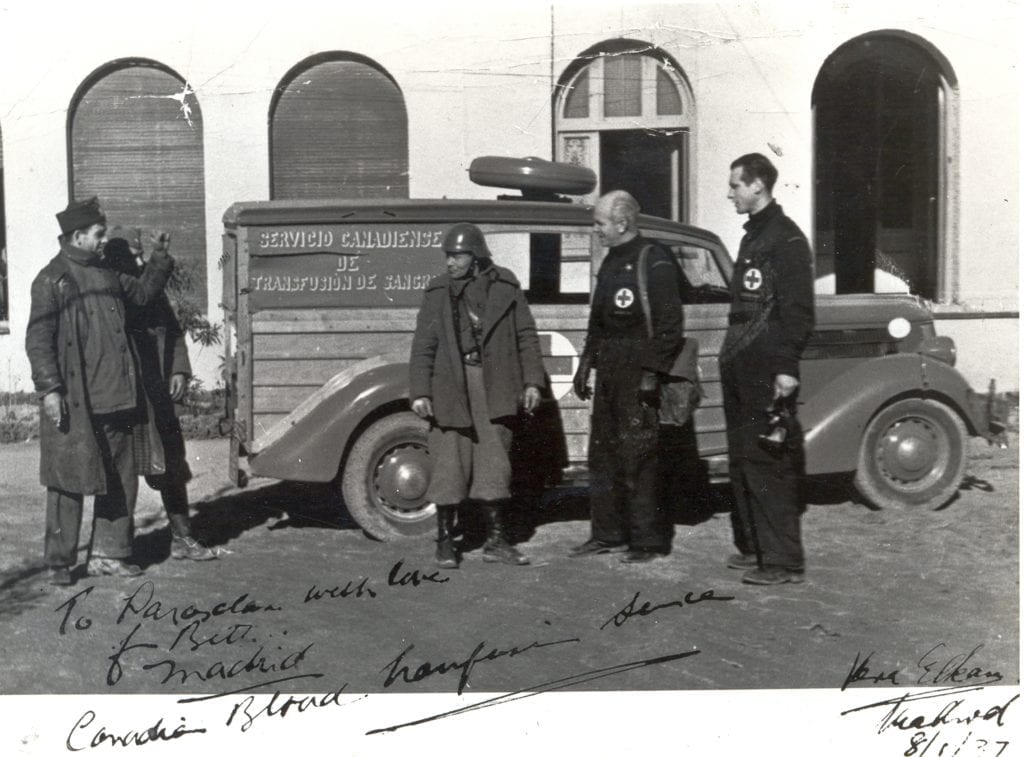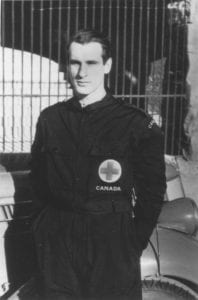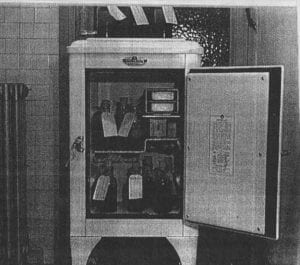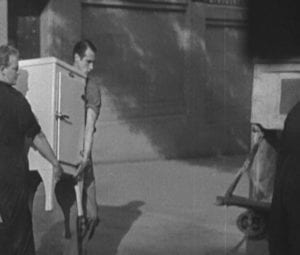Anne Marie Appelgren
Málaga, Spain

“The wounded are dying, searching for blood. Now the blood can move, now the blood can search out the wounded.” – Norman Bethune
“Bethune was a man of destiny. He lived and died for blood.” – Hazen Sise
On a gray evening in London in the fall of 1936, a young Canadian architect by the name of Hazen Sise was relaxing in his Chelsea studio, browsing through a pile of new books. It was supposed to be a lazy Sunday afternoon. Then the doorbell rang, and the rest is history.
The unexpected, rain-soaked caller was a middle-aged man of medium height, ramrod erect, and sporting a military mustache. He was wearing a trench coat and a porkpie hat. Norman Bethune introduced himself as an MD and a fellow Canadian, promptly strode in and stated, “The world war has started. It is democracy against fascism and it’s in Spain where the great issues of our time will be fought out.”
Norman Bethune had practiced surgery at the Royal Victoria Hospital in Montreal, and the Hopital du Sacre Coeur at Cartierville, where he was Chief of Pulmonary Surgery and Bronchoscopy. He had participated as a volunteer in World War I. After a visit to the USSR, he believed in communism as an antidote to the “disease” of nazism and fascism.

Bethune, Beth to his friends, proceeded to lay out his plan, and before Sise knew it, he heard himself blurting out, “My gosh, I’d like to go with you!”
So began an entirely new chapter in both of their lives. Dr Bethune had found a calm, good-natured companion, something of a Doctor Watson to his own erratic brilliance á la Sherlock Holmes. Bethune possessed charisma and a contagious zest for life. Hazen Sise was a strong man in his early thirties, and as idealistic as himself. Sise understood Bethune better than many. Some were taken aback by his short temper; he could be impatient, some considered him arrogant. “He was existing on the raw edge of his nerves. Always outpouring energy, even though he was living on one lung and frequently almost collapsed.”
Bethune and Sise arrived in Madrid after driving through Paris, eager to fight Franco’s rebel forces of Spaniards and Moroccans aided by Italian fascists and Nazi Germans. Even though they were rejected by the International Brigade, perhaps due to lack of Spanish, they refused to give up. Bethune had wished for something to do “for the human race.” Indeed, he found it. A poem he wrote before leaving Canada would later seem prophetic: “. . . Above the shattered mountain tops / Last night, rose low and wild and red / Reflecting back from her illumined shield / The blood bespattered faces of the dead.”
*
A workable system for the refrigeration and movement of quantities of blood was needed. Bethune believed that blood could be kept and used for much longer than thought possible with the help of sodium citrate, a method developed during World War I. Bethune quickly set out to organize the collection of blood, as well as transportation to the frontiers. A long queue of people, more than twelve hundred, waited outside the clinic in Madrid the day after their public plea for donations. Sise was there. “It was really a very exciting moment. I believe that Bethune also realized that the giving of blood had an enormous emotional punch to it.”
*
Christmas was coming and Norman Bethune saw no contradiction between doing good work for humanity and enjoying the pleasures of this world. He never pretended to be a saint.
“Now we’ve got this unit just beginning to tick. Let’s pile into the car and go up to the Sierra de Guardarrama.”
“We all used to drink a certain amount and Bethune, of course, was a sybarite.”
It was a lovely day of clean cold air and time for a short but much needed break. The image of Norman Bethune, shielding his eyes against the bright sunshine on top of the mountain, would stay with Hazen Sise forever. He captured this peaceful moment on camera.
*

An all-too-common cause of casualties on the battlefield was circulatory shock resulting from a sudden loss of blood. To be able to administer blood transfusions in situ, Bethune developed a mobile blood transfusion unit like the one created by Dr. Durán y Jordà, whom he consulted in Barcelona where Thomas Worsley, a fellow Canadian, decided to join them.
A kerosene-operated refrigerator loaded with blood was fitted into a gray-painted modified Ford station wagon. There was also a sterilizer, gas-operated autoclave, kerosene-operated incubator, water distiller, and bottles to hold blood, amongst other supplies and instruments. The Red Cross had been painted on the rear, and the text on the sides read “Servicio Canadiense de Transfusión de Sangre.”
Bethune was rightfully proud. “I’ve succeeded in unifying all remaining Spanish transfusion units under us, serving one hundred hospitals and clearing stations on a thousand-kilometer front. It’s the same as organizing a milk route.”
Arriving in Almería on Wednesday the tenth of February, they were informed that Málaga had fallen. To help the population in the face of fascist invasion, they bravely drove towards enemy lines along the coast, despite warnings. Three days earlier, a sign had come up outside the civil governor’s office in Málaga: Sálvese quien pueda! Run for your life!
Sise described the scene. “We began to run into this pathetic procession of people. First little groups, then it got thicker and thicker, it was just like a river of humanity driving against us.”
At the beginning there were a few, the lucky ones, with donkeys, horses, or trolleys, then more followed, until the road was filled with traumatized refugees. They were soon surrounded by people begging for help: “Take this child!” and “See this one, she is wounded!”
Hazen Sise’s photographs bear witness to the tragedies. Whenever Hazen Sise had to drive through a heavy snowfall, these images would come to his mind. “The snowflakes coming at you and at you and at you and at the windshield. I am always reminded of these people.”
*

Bethune had described the terror of seeing the bombs fall like “great black pears” in Madrid, and then “a thunderous roar, from heaps of huddled clothes on the cobble stones, blood begins to flow. These were once live women and children.” But on “Death’s road” they were confronted by another, perhaps even more desperate and grotesque vision of hell. Up to one hundred fifty thousand men, women, and children had fled their homes in panic, two hundred kilometers from relative safety, in Almería. The lack of food, clothing, and other necessities was heartbreaking to see. They were abandoned by military leaders and left behind. Their attackers were urged on by a general who ranted every night on Radio Seville, threatening the population of Málaga and a growing number of refugees from other parts of Andalucía with rape, murder, and mayhem. Typhus and dysentery were rampant due to unsanitary conditions. Rumors of decapitations and other horrors spread like wildfire.
“The Crime on the road Málaga-Almería” written and published by Dr. Bethune in 1937 and illustrated with Hazen Sise’s photographs, is the doctor’s eyewitness account of what he and his companions saw and experienced. Women gave birth amongst dead bodies strewn along the road. The Canadians counted more than a thousand orphaned children, many of them with only one piece of clothing on their body. Wounded and elderly, unable to take another step, resigned. One of the refugees, a child at the time, could never forget the sight of a woman killed by falling stones after one of the nearby vessels opened fire. At her breast a living infant.
Bethune and his companions unloaded supplies to transport as many refugees as possible in their small van to safety. To choose was hard when everybody needed help. Sise and Worsley drove tirelessly for three days and three nights, living on dry bread and oranges. In Almería, the refugees were given medical treatment and transfusions. Sise has described the wonder of seeing the color rise in their faces. “Spaniards bursting out ‘Mamma mia! Mamma mia!’ They came alive, right under your eyes, within the sphere of several minutes.”
Then came the senseless and barbaric bombardment of Almería on the evening of the twelfth of February. The alarm sounded a mere thirty seconds before the airplanes dropped ten great bombs, directed at forty thousand exhausted refugees. Norman Bethune held three dead children in his arms, a bright flame of hate burning in his brain, in this hellish scenario where fifty civilians lost their lives.
*
Bethune could not stay in Spain. He returned to Canada where he gave lectures, collecting funds for orphaned Spanish children. In 1938 he headed for China, where a war was being fought with Japan. Hazen Sise also returned to Canada where he remained an outspoken advocate for social justice, a faithful follower of the modern movement in art and architecture, and a photographer. Hazen Sise died in 1974.
Norman Bethune died from septicemia in 1939, contracted during an operation. He was buried in China as a national hero. He was forty-nine years old.
The memory of Hazen Sise, Norman Bethune, and Thomas Worsley has been honored in Andalucía in various ways. Not far from the center of Málaga it is possible to contemplate the sun setting across the Mediterranean Sea from a walkway called “Paseo de los Canadienses.” At the beginning of February each year, people gather to commemorate the exodus in a kind of pilgrimage from Málaga to Almería, over the course of ten days.
References
- Bethune’s book, with the photographs of Hazen Sise, is possible to read online: https://archive.org/details/TheCrimeOnTheRoadMalaga-almeriaNarrativeWithGraphicDocuments
- An article in Spanish about the exodus from Málaga: https://www.eldiario.es/andalucia/Norman-Bethune-heroe-terror-desbanda_0_349966097.html
- Documentary, containing an interview with Hazen Sise: https://www.youtube.com/watch?v=Zrf8tUKorz4&t=2039s
Further reading
- Roderick Stewart. Bethune. New Press. Toronto, 1973.
- Roderick Stewart. The Mind of Norman Bethune. Fitzhenry & Whiteside. Don Mills, 1977
- Ted Allan and Sydney Gordon. The Scalpel, The Sword. Mclelland and Stewart, Toronto, 1989.
- Adrienne Clarkson. Norman Bethune. Penguin Press. Toronto 2009.
- Roderick and Sharon Stewart. The life of Norman Bethune. McGill- Queen’s University Press, May 2011.
- Roderick Stewart and Jesus Majada. Bethune in Spain. McGill-Queen’s University Press. London, 2014.
- Irving Rosen. ”Norman Bethune’s mobile blood transfusions” Hektoen International. December 2019.
- Dr. Satish Saroshe. “Dr. Norman Bethune: a tale of military heroism.” Hektoen International. 2016.
ANNE MARIE APPELGREN was born in Finland. Her family emigrated to Sweden when she was a child. Anne Marie has lived in various Spanish towns and cities since her first visit, almost forty years ago. She has published two novels in Swedish and is working on a family saga. She was named after her paternal grandmother, killed during a Russian air strike in Turku, Finland, 1941. She is currently living in Málaga and has a Bachelor of Arts in Creative Writing.
Submitted for the 2019–2020 Blood Writing Contest

Leave a Reply